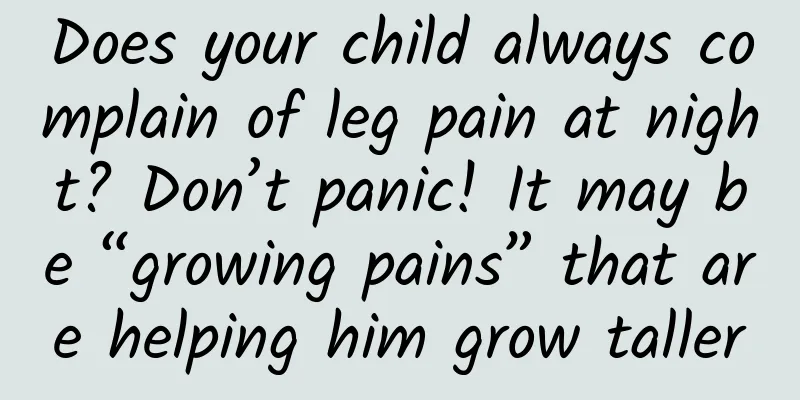Does your child always complain of leg pain at night? Don’t panic! It may be “growing pains” that are helping him grow taller

|
On the road to growth, every teenager is a brave explorer. Their bodies are like the rising sun, full of infinite possibilities and vitality. However, in this journey full of miracles and changes, many teenagers will encounter a mysterious and common phenomenon - growing pains. Growing pains, a term that sounds familiar and a little bit strange, is actually a small episode in the process of adolescent growth. It quietly reminds us that the body is developing and changing at an astonishing speed. 01Why do we have growing pains? Growing pains are a kind of "growing pain" that many children feel in their legs (especially around the knees, calves or front thighs) at night or after strenuous exercise, but no obvious trauma or disease can be found during examination. It generally does not have a significant impact on children's activities, and as they grow older, the bones and muscles gradually coordinate their growth, and the pain symptoms will gradually ease or disappear. Image source: Pixabay Why do adolescents experience growing pains during their development? This is mainly due to the following reasons: 1. Bone growth is too fast: During the rapid growth period, the growth rate of long bones (mainly distributed in the limbs of the human body, such as thigh bones and upper arm bones) is not synchronized with the growth rate of ligaments and muscles. The growth rate of bones may exceed the growth rate of muscles and ligaments, causing muscles and ligaments to be stretched, thereby causing pain. This is one of the most common causes of growing pains. 2. Calcium deficiency: Calcium is an important element necessary for bone growth. If adolescents do not take in enough calcium during their development, it may lead to restricted bone growth, which in turn causes pain. Calcium deficiency can also increase nerve excitability, causing symptoms such as muscle pain and muscle cramps. Therefore, calcium deficiency is also a possible cause of growing pains. 3. Muscle fatigue: Teenagers are usually more active, and long periods of exercise or standing may lead to overuse of muscles, resulting in fatigue and pain. Proper rest and massage can relieve muscle fatigue and reduce pain symptoms. In addition, although psychological factors (such as excessive life or study pressure) may also be related to growing pains, this association is relatively weak and more often leads to the occurrence of pain indirectly by affecting the overall health of adolescents. 02How to determine growing pains? To determine whether a child is experiencing growing pains, a comprehensive consideration can be made from aspects such as age group, time of occurrence, pain location, pain type and characteristics. Age group: Growing pains mainly occur during childhood and adolescence, especially in children aged 3 to 12. Children of this age group are in a stage of rapid growth and development, and the growth rate of bones and muscles may not be synchronized, so growing pains are more likely to occur. Some children may grow and develop late, and may experience growing pains before the age of 18. Occurrence time: Growing pains usually occur at night or during rest, because children are in a relaxed state and are more sensitive to pain. During the day, due to the large amount of activity in children, even if they feel uncomfortable, they may not be able to notice it easily because they are focused on other things. Pain location: Growing pains mainly occur in the lower limbs, especially around the thighs, calves and knees. The pain usually does not involve joints, but pain in muscles or tendons. Sometimes pain may also occur in the groin area. It should be noted that the location of growing pains is not fixed and may occur in different parts in turn. Pain: Growing pains usually present as dull, cramp-like pains, occasionally accompanied by a stabbing pain. The pain may last from a few minutes to a few hours, but generally no more than 30 minutes. In rare cases, the pain may last for more than an hour. The degree of pain varies from person to person. Some children may only feel mild discomfort, while others may feel more severe pain. Therefore, we can see that growing pains do not necessarily mean the pain in the feet, and similarly, foot pains do not necessarily mean growing pains. Parents should still be careful not to subconsciously say that children are growing when they say their feet hurt. In fact, there are many other diseases that can cause leg pain, such as soft tissue injuries, greenstick fractures, etc. Especially when children are at an age where they are very active, they may still suffer from muscle strains caused by excessive exercise, or fractures caused by accidental bumps and bumps at school. Parents must be more careful. If they find any abnormalities in the painful area of their children (swelling, bruising, deformity, edema, etc.), they should seek medical attention in time, do relevant examinations, and find the real cause. 03Does growing pains require intervention? Whether growing pains require intervention depends mainly on the degree of pain and the specific situation of the child. After all, people's physical constitutions cannot be generalized. Mild pain: If your child only has mild pain occasionally and it does not affect their daily life and activities, then no special intervention is usually needed. This pain may be a normal growth and development phenomenon, and the symptoms will gradually decrease or disappear as the child grows older and the bones and muscles gradually coordinate. Moderate to severe pain: If your child has moderate to severe pain that lasts long enough to interfere with their daily life and activities, then appropriate intervention is warranted. This can help relieve the pain, improve your child's quality of life, and avoid other problems that may arise from the pain. 04Growing pains, how to intervene? Nutritional supplementation: Make sure your child gets enough nutrients, especially calcium and vitamin D, which are essential for healthy bone development. You can increase the intake of these nutrients through dietary adjustments, such as drinking more milk, eating calcium-rich foods such as soy products, and getting enough sun to promote the synthesis of vitamin D. It is worth mentioning here that calcium supplementation during growing pains may not necessarily be more effective, or in other words, do not wait until your child has growing pains to start calcium supplementation. Calcium is an important element for bone growth and also shoulders the important task of maintaining neuromuscular function, but the absorption effect of exogenous calcium supplementation varies from person to person. Some children may respond better to calcium supplementation and their pain symptoms may be significantly relieved; while some children may not see much effect. Therefore, if you are really unsure whether your child needs calcium supplementation, you can go to the hospital for some basic growth and development examinations first. It is always right to supplement calcium according to the doctor's orders. Reduce strenuous exercise: Although exercise is beneficial to the growth and development of children, during the onset of pain, the time of strenuous exercise should be appropriately reduced to avoid excessive muscle fatigue. Children can be allowed to do some relaxing activities, such as walking, to promote blood circulation and relieve muscle tension. Image source: Pixabay Local heat and massage: Using a hot towel or hot water bottle to heat the painful area can increase blood circulation and accelerate the excretion of lactic acid metabolites, thereby relieving pain. At the same time, proper massage can also relax tense muscle tissue and achieve analgesic effects. However, attention should be paid to the heat compress time and massage intensity to avoid discomfort. Drug treatment: If the pain persists or worsens, you can use appropriate drugs for treatment under the guidance of a doctor, such as anti-inflammatory and analgesic drugs (acetaminophen, ibuprofen, etc.), but they must be used under the guidance of a doctor to avoid abuse and side effects. In short, growing pains are a common phenomenon that many teenagers experience during their growth. Although it may cause discomfort, it is usually harmless and is a positive sign of rapid physical development. Let us look at growing pains with a positive attitude - it is a small episode on the road of growth and a sign that the child's body is thriving. Through scientific management and proper care, we can help teenagers get through this period smoothly! Source: Chongqing Science and Technology Museum Author: Yingjiang, medical major Audit expert: Li Chunli Statement: Except for original content and special notes, some pictures are from the Internet. They are not for commercial purposes and are only used as popular science materials. The copyright belongs to the original authors. If there is any infringement, please contact us to delete them. |
>>: A small stone "destroyed" a kidney! His experience sounded a wake-up call for everyone
Recommend
Don’t let happiness become an invisible price for your health when drinking during the New Year
Quan Haoxian, Tongji Medical College, Huazhong Un...
How many days does it take for Amaryllis bulbs to germinate? What should I do if Amaryllis bulbs don't germinate?
Amaryllis is a common flower in life. It is deepl...
Symptoms of lumbar disc herniation in women
Nowadays, many women suffer from sub-health condi...
A large number of products have been put on the market recently! Someone was sent to the emergency room after eating it, and the doctor urgently reminded →
Recently, cherries have been put on the market in...
Is brown bleeding normal during pregnancy?
If a woman has brown vaginal discharge during pre...
How many days will the bleeding last after taking the medicine?
Many people are caught off guard by an unexpected...
What are the regulations for prenatal check-up leave?
With the progress of society, there is more and m...
A must-read for patients with ovarian cysts
The occurrence of ovarian cysts can cause a lot o...
Do I need to stay in bed for three months after IVF?
In vitro fertilization is a surgical method that ...
"Don't wait for foreign countries to be immune, China will be in danger instead"
Academician Zhong Nanshan called on the public to...
Three months of pregnancy morning sickness worsens
Pregnancy has become a common occurrence around u...
Four ways to regulate endocrine disorders
Women's endocrine system is very important. I...
The protein content is higher than eggs, and the dietary fiber is better than oats! This ingredient is seriously overlooked! It’s a pity to miss it
If you have experience in losing weight or exerci...
Women urinate with pain and blood after urination
When women have to urinate urgently, they will fe...
Crawley Brand Social Media Rankings in August 2022
In the Internet age, the influence of social medi...









